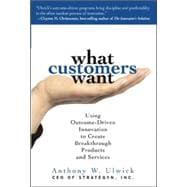
Note: Supplemental materials are not guaranteed with Rental or Used book purchases.
Purchase Benefits
What is included with this book?
Anthony Ulwick (Lantana, FL) and his innovation practices were recognized by HBR editors as some of the best business ideas of 2002. Through his company, Strategyn, Ulwick has implemented his innovation approach at organizations such as Microsoft, Hewlett-Packard, and Pfizer.
| Acknowledgments | xi | ||||
| Introduction: Moving Beyond the Customer-Driven Paradigm | xiii | ||||
| Chapter 1 Formulating the Innovation Strategy: Who Is the Target of Value Creation and How Should It Be Achieved? | 1 | (14) | |||
|
2 | (4) | |||
|
6 | (3) | |||
|
9 | (4) | |||
|
13 | (2) | |||
| Chapter 2 Capturing Customer Inputs: Silence the "Voice of the Customer"—Let's Talk Jobs, Outcomes, and Constraints | 15 | (24) | |||
|
16 | (1) | |||
|
17 | (2) | |||
|
19 | (4) | |||
|
23 | (9) | |||
|
32 | (3) | |||
|
35 | (4) | |||
| Chapter 3 Identifying Opportunities: Discovering Where the Market Is Underserved and Overserved | 39 | (22) | |||
|
40 | (1) | |||
|
41 | (3) | |||
|
44 | (4) | |||
|
48 | (4) | |||
|
52 | (2) | |||
|
54 | (7) | |||
| Chapter 4 Segmenting the Market: Using Outcome-Driven Segmentation to Discover Segments of Opportunity | 61 | (22) | |||
|
62 | (1) | |||
|
63 | (3) | |||
|
66 | (2) | |||
|
68 | (1) | |||
|
69 | (5) | |||
|
74 | (6) | |||
|
80 | (3) | |||
| Chapter 5 Targeting Opportunities for Growth: Deciding Where to Focus the Value Creation Effort | 83 | (16) | |||
|
84 | (1) | |||
|
85 | (5) | |||
|
90 | (4) | |||
|
94 | (1) | |||
|
95 | (4) | |||
| Chapter 6 Positioning Current Products: Connecting Opportunities with Valued Product Features | 99 | (20) | |||
|
101 | (2) | |||
|
103 | (4) | |||
|
107 | (2) | |||
|
109 | (5) | |||
|
114 | (1) | |||
|
115 | (4) | |||
| Chapter 7 Prioritizing Projects in the Development Pipeline: Separating the Winners from the Losers | 119 | (18) | |||
|
120 | (3) | |||
|
123 | (5) | |||
|
128 | (5) | |||
|
133 | (4) | |||
| Chapter 8 Devising Breakthrough Concepts: Using Focused Brainstorming and the Customer Scorecard to Create Customer Value | 137 | (30) | |||
|
139 | (1) | |||
|
140 | (3) | |||
|
143 | (4) | |||
|
147 | (4) | |||
|
151 | (3) | |||
|
154 | (9) | |||
|
163 | (4) | |||
| Epilogue: Tactical Tips for Managers | 167 | (10) | |||
| Glossary | 177 | (12) | |||
| Bibliography | 189 | (2) | |||
| Index | 191 |
The New copy of this book will include any supplemental materials advertised. Please check the title of the book to determine if it should include any access cards, study guides, lab manuals, CDs, etc.
The Used, Rental and eBook copies of this book are not guaranteed to include any supplemental materials. Typically, only the book itself is included. This is true even if the title states it includes any access cards, study guides, lab manuals, CDs, etc.